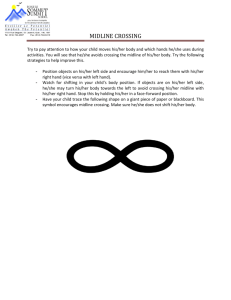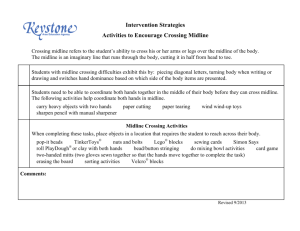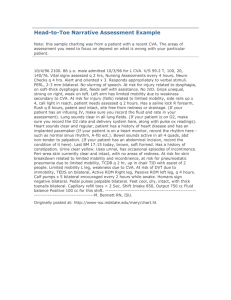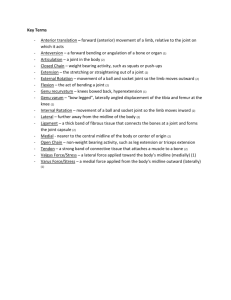Assisting Early Literacy
advertisement
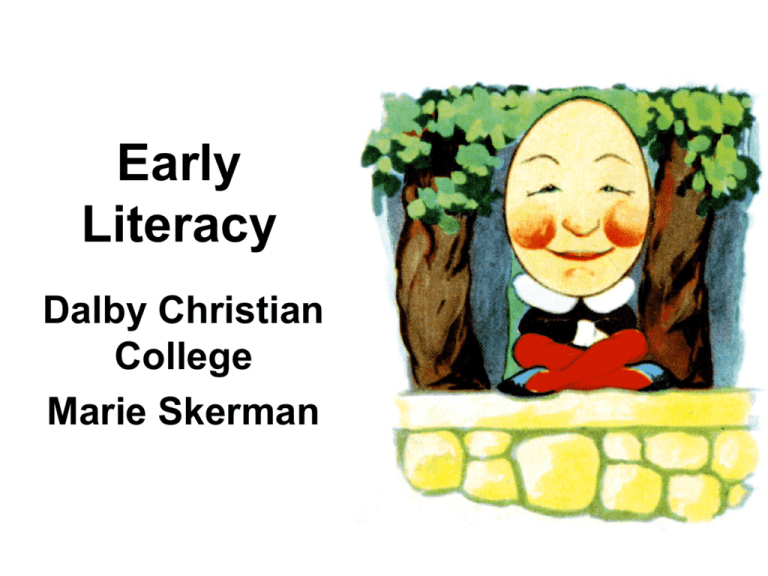
Early Literacy Dalby Christian College Marie Skerman What is Literacy ? • Being able to communicate your thoughts effectively through :• Writing • Speaking • Reading 2 Brain Development • Recent brain research has revealed that the early years of life are more critical to a child’s development than we ever realized. • Children’s brains begin to develop from the moment they are born. 3 New Born – 2 Months The baby begins to vocalize 4 Up to 10 months Babies under 10 months usually babble in the phonemes of their own language. Repetition of sounds begins to strengthen connections for these sounds in the brain. 5 6 to 18 months At 18 months many children begin adding words or vocab at a rate of one new word every two hours or so. At this stage the brain development and metabolic activity and neural connections are higher than at any other time in life. The crucial connections that determine how clever, creative and imaginative a child will be are already laid down by the time the child turns one. Mem Fox 6 24 months – 36 months Simple phrases are formed with around 200-300 words in vocab. Phrases are usually word sequences they have heard. Children’s neural pathways for language develop rapidly. 7 Literacy Development The first 3 years of life are a cognitively critical time for developing children’s language capacity, vocab and writing skills. 8 Literacy Development The environmental aspects of children’s lives, their experiences and the opportunities they are given all play an important role in building their brains with a strong foundation for later literacy success. 9 Literacy • Being able to communicate your thoughts effectively through :• Writing • Speaking • Reading 10 Speaking • Speech Development • Language Development 11 Speech Development • Producing the sounds that form words • Physical activity that is controlled by the brain • Requires coordinated movement of tongue, lips, jaw, palate, lungs and voice box. • It takes a lot of practice and that is what children are doing in the first 12 months • Some sounds do take longer than others 12 Language Development • The words that your child understands and uses as well as how to use them • Includes spoken and written • Vocabulary • Grammar • Discourse o o Ability to structure sentences into conversation. Rules for telling stories, poems and jokes, writing recipes and letters 13 Speech and Language • Learning to speak is probably one of the greatest accomplishments of an individual’s life. • Parents and families have a profound influence upon children, not only vocabulary but also on the literary experience they provide. 14 Language Development Oral language is so important it can predict at age 3 if a child will have problems with reading. (Building the Reading Brain) 15 Language Development • Your child’s ability to communicate and express and understand feelings. • Supports thinking and problem solving and developing and maintaining relationships. • Learning to understand, use and enjoy language is the critical first step in literacy and it is the basis for learning to read and write. 16 Encouraging Language Development • Talk, talk, talk, talk. Talk frequently and naturally- children do not learn how to talk unless they are spoken to • Talk to your baby and treat them as a talker. In the first year assume they are talking back to you when they make sounds and babbles. Babble to each other. • Respond to gestures and words. – respond to their attempts to communicate. E.g. pointing to a toy – respond as if they are saying ‘Can I have that’ 17 Encouraging Language Development • Talk about what is happening – use lots of different words. As they become toddlers continue to talk- tell them things that are happening and talk about things they are doing. • Introduce new words – help them learn the meaning and context of words • Share books • Follow your child’s lead in conversations. What topic did they start? 18 Encouraging Language Development • Repeat and build on what a child says e.g. If they say ‘apple’ you could say ‘Do you want an apple? I want an apple too. Let’s have a red apple together.’ • Children can listen to more complex language than they speak • When they start telling stories get them to talk about the past and the future as well as the present. • Rhymes and songs 19 Encouraging Language Development The Nursery Rhyme Effect When two sounds are similar they excite the same cells and connections in the brain. As these sounds are repeated the neural connections become stronger and the sounds become more easily recognizable and familiar. The brain also begins to distinguish between sounds that are alike or different. This is essential to phonemic awareness. They also develop a bank of vocabulary. 20 Encouraging Language Development Some researchers have found that early knowledge of nursery rhymes is strongly and specifically related to the development of more abstract word processing skills and future reading ability. (Building the Reading Brain) Dr Seuss 21 Reading Reading problems are often difficult to fix but can be easily prevented. Prevention comes long before school. The first day of school is almost too late. (Mem Fox) Language Development 22 Reading Just think if we took all of the words available to us and read them in the dictionary to our children – would that help with language development? With the creativity and imagination and letting the words flow together in the right order there is a pleasure and an awakening of the senses and emotion. 23 What does reading with your child do? • Gives an enjoyable time with them – builds relationship • Encourages familiarity with reading • Helps them to start to appreciate what books have to offer • Helps them to understand that print has meaning • Develops a larger vocabulary and helps them become familiar with language patterns 24 What does reading with your child do? • It stimulates memory and develops and reinforces background knowledge • Improves thinking and problem solving skills • Books and experience go together 25 Encourage a love of reading. • Show children that reading helps get information, answer questions and discover interesting things • Don’t make it a chore to share a book. Don’t be surprised if they want to read the same one over and over. • Visit the library • Participate in library story times and reading clubs • Own library card 26 Encourage a love of reading • Collect different types of books (great present) • Repetitive chorus – encourage them to join in • Speak the words of characters with expression • Make time available to look through books 27 Choosing Books for Babies (0 - 18 months) • pictures of familiar objects, and with a strong rhythm and rich language sounds. • select books with simple, large illustrations. High contrast black and white graphics work well, as do solid colours • Board books and cloth books choose sturdy books that a baby can handle safely. • Nursery Rhyme books - select books with rhymes and poems that have strong rhythm and rich language sounds 28 Choosing Books for Toddlers (19 months - 3 yrs) • Toddlers like predictability and repetition. • Any of the books recommended for babies. • Storybooks - select books about what is familiar to your child, such as your child's favourite things or your family's culture. • Alphabet and Counting Books. 29 Choosing Books for Preschoolers (3 - 5 years old) • Preschoolers like to be involved. Let them help choose the books, or have them turn the pages as they follow along as you read and share stories. • Pre-schoolers are ready for longer, more complex stories. • Rhyming and nonsense books, such as Dr. Seuss books are popular • Try audiobook sets - books with CD that read the story while you and your child turn the pages of the book. • Online stories - electronic stories that have interactive elements- can be a nice change. • Some pre-schoolers are ready for beginning readers. 30 Choosing Books • The library is a big place with lots of shelves, bindings, labels and writing. Guide children. • Become familiar with authors • Some purposeful well chosen books by you • Some own choice by child • Picture books enrich language development • Seek out reading lists 31 Ten read-aloud commandments Mem Fox 1. At least 10 wildly happy minutes 2. 3 stories a day 3. Read aloud with animation 4. Read with joy and enjoyment 5. Read the stories kids love 6. Lots of language 7. Look for rhyme or repetition 8. Play games with things on the page 9. Do not get tense 10.Everyday, Mums and Dads 32 Talking about Books • • • • • • • • • Sequencing Beginning Sounds Prediction Print always stays the same Connect to text – relate to own experience Asking questions Inferences Discuss new words Don’t kill the moment! 33 Mechanics of Reading • Holding a book • Run you finger under words as you read • Show how you begin reading at the top of the page • Point out words that are repeated – see if they can find them if used again • Pictures have meaning 34 Beyond Books • Go places and do things. The more experiences children have the easier it can be to read and develop vocabulary. It is easier to read about things if you have had the experiences • Everyday reading- directions, grocery list, labels, signs, computer • Limit TV and IT • Books on CD 35 Gross Motor Skills Gross motor skills involve movement of the large muscles in arms, legs, and torso. Gross motor activities include walking, running, skipping, jumping, throwing, climbing and many others. It may be easiest to think of “gross motor” skills as skills most utilized on a playground. 36 Gross Motors Skills What is Bilateral Integration? Bilateral integration is a fancy term that refers to the ability to smoothly perform actions using both sides of the body simultaneously. Successful gross motor movements are a result of bilateral integration. 37 Gross Motors Skills There are several stages of bilateral integration that develop in sequence: Symmetrical Bilateral Integration. Symmetrical bilateral integration involves both sides of the body working in mirror-image unison, where the actions on one side of the body mirror the actions performed on the other side. 38 Symmetrical Bilateral Integration. 39 Reciprocal Bilateral Integration Reciprocal bilateral integration involves moving both sides of the body at the same time in opposite motions. 40 Asymmetrical Bilateral Integration Asymmetrical bilateral integration involves each side of the body acting in a different way to complete a single specific task. For example, one foot may kick a ball as the other foot plants on the ground and balances the body. 41 Asymmetrical Bilateral Integration 42 Crossing the Midline • The “midline” is the imaginary line down the centre of your body from the top of your head to your toes). Crossing the midline involves instinctively reaching across your body to complete an activity. 43 Crossing the Midline 44 Crossing the Midline Successful reading depends on an ability to cross the midline. When reading, a child’s eyes must follow along the entire horizontal length of the page, before moving to the next line. 45 Crossing the Midline Without well developed bilateral integration, a child will likely read the first few words on a page and then pause. After thinking for a moment, he may continue to read the second half of the page. This pause is because the child was unable to instinctively cross the midline so he needed to pause and needed to deliberately move his eyes to the next word to resume reading 46 Writing Handwriting Story Writing 47 Handwriting Stages • Early Scribbling – Random marks – More interested in the physical experience than the marks • Controlled Scribbling – Marks become more controlled – with the development of motor skills – Attempt to draw a straight line or circle – Begin to distinguish between drawing and writing 48 Handwriting Stages • Pictorial Stage – Marks and forms begin to be distinguishable – Understands that pictures and words are different symbols • Letter Stage – Begin to write letters to represent words and syllables – Often can write own name 49 Fine Motor Development • Coins or buttons – picking up coins or buttons (if sure they will not put in their mouths • Tweezers – picking up cotton wool balls with tweezers is great for developing the opposition of fingers. • Play dough – cutting with a knife is a great strengthening task. • Newspaper - encourage children to tear the paper into strips with their thumb and index finger and to then crumple the paper into balls • Spray bottles - these are perfect for developing muscle strength in the palm, wrist and fingers. Try adding some drops of ‘food colouring’ for magic spray! • Hand–eye coordination • Balance • Spatial awareness 50 Crossing the Midline Successful writing depends on well developed asymmetrical bilateral integration and an ability to cross the midline. First, a child must use one hand to control the pencil and the other hand to position and stabilize the paper (asymmetrical bilateral integration). Then, a child must use one hand to write words along the entire horizontal length of the page, without switching the pencil from the left hand to the right hand at the mid-way point of the page (crossing the midline). 51 Crossing the Midline Without well developed asymmetrical bilateral integration or an ability to cross the midline, a child will limit his drawing to the portion of the paper closest to his writing hand since he cannot comfortably reach his hand to other areas of the paper and his non-writing hand does not instinctively readjust the paper’s position. 52 Story Writing Developing Good Writers • Language and Vocab development • Exposure to great writing (Reading lists) • Collect things for children to write on (junk mail, envelopes, cheap shop) • Have a variety of pens and chalks. 53 Development Accomplishment of Child from Birth -3 (Taken from National Research Council’s publication‘Preventing Reading difficulties in Young Children’) • Recognize a specific book cover • Pretends to read books • Understand books are handled specific ways • Book Sharing • Labels objects in books • Vocalization in play – enjoys rhyming language and nonsense play 54 Development Accomplishment of Child from Birth -3 (Taken from National Research Council’s publication‘Preventing Reading difficulties in Young Children’) • Comments on characters in books • Looks at pictures in books and realizes it is a symbol for a real object • Listens to stories • Requests/commands adults to read • May begin attending to specific print such as letters and names • Uses increasing purposeful scribbling and writing • Occasionally seems to distinguish between drawing and writing • Produces some letter-like forms and scribble with some features of English writing. 55
